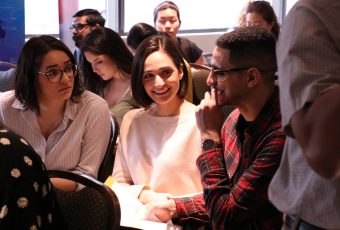Monash Computer Systems Engineering duo win international accolade for wearable computer
Monash University researchers have scooped an award at an international symposium on wearable computers.
A Monash PhD student Titus Tang and his supervisor Dr Wai Ho Li, from Monash Vision Group and the Department of Electrical and Computer Systems Engineering won the Best Paper Award at the 18th International Symposium on Wearable Computers in Seattle, a major conference for specialists in the field.

Titus presented the research on the EyeWear prototype which assists vision impaired users by translating 3D visual information into 3D audio cues, to more than 700 delegates.
After the win, Titus was invited to visit Microsoft’s research campus in Seattle as well as a Ubiquitous Computing Research Lab at the University of Washington sponsored by Belkin and other industry partners.
Titus said giving the presentation was a nerve-wracking experience because it was the first time he showcased the work to fellow researchers working in the field of wearable computers.
“We knew our paper had been nominated for an award before the conference and we were also told that the best paper award would be judged not just by the paper itself, but also by the quality of the podium presentation. This certainly added to the pressure I felt on the day,” Titus said.
“But it feels great that our work is being recognised by the research community. The award has certainly boosted confidence in my own research.”
The assistive system, which Computer Systems Engineering student Titus developed over the last three years with the help of his supervisor Dr Li, uses a wearable 3D camera and fast computer vision to detect objects in the environment. The 3D location of detected objects is then conveyed to the user in real time using 3D audio much like virtual objects in video games.
Whereas previous electronic aids have been used for navigational tasks, the Monash system is the first to detect and sonify nearby objects. In tests, the aid provided volunteers who were blindfolded, with enough accuracy to reach out and grasp an object by hand.
Titus’ supervisor Dr Wai Ho Li said that there was tough competition for the award.
“Just getting the research accepted was no mean feat as the symposium only accepts ten per cent of submissions as full papers. Despite the tough competition, the research won the best paper award,” Dr Li said.
“The fact that we won speaks volumes about the quality of the work. Titus did a great job presenting our work to some of the world’s leading experts on wearable computers, including researchers from Google and Microsoft. In an ocean of research focused on mobile devices with visual touchscreens, our work on an accessible audio-only interface stood out amongst the crowd.”
The assistive system was designed after discussions with Vision Australia and vision-impaired people, which revealed that traditional aids like the white cane and guide dogs have limitations—one of which is finding an object without touching it. The Monash University system is a first step in addressing these deficiencies, with user trials on vision-impaired volunteers currently underway.
Titus said the work was challenging because it was dependent on volunteers to assist with the trials.
“I have personally collected about 1,500 data points from my user trials. Each trial is labour intensive and it is a challenge to recruit volunteers and then getting everybody’s schedule right,” he said.
“But what’s significant is that all the volunteers I have worked with have been extremely helpful and enthusiastic about the project.”
The research was carried out within Monash Vision Group, who are developing a bionic eye that interfaces directly with the human brain. The knowledge gained about 3D sensors, wearable computers, computer vision and 3D audio has the potential to greatly improve the efficacy of the Monash Vision Group device and other visual prostheses.
Monash University Department of Electrical and Computer Systems Engineering
The Department of Electrical and Computer Systems Engineering (ECSE) is an extremely diverse department specialising in telecommunications, RFID, biomedical engineering, robotics, sensing, vision, systems-on-a-chip and smart energy systems. These applications are based on fundamental research in electronics, photonics, signal processing, communications theory, artificial intelligence, real-time software, optimization, electromagnetics and numerical modeling.
The ECSE program at Monash University equips students with the skills necessary to succeed in this rapidly changing industry, with graduates going on to make an impact in many areas. The department is at the centre of ECSE research, with Monash researchers working on innovative projects including bionic vision, augmented reality, medical diagnostics, optical communications, wireless communications, sensor systems and high-voltage engineering. This research is creating and supporting high-tech industry.
*































Ask A Question
Ask us about your program of interest, or if you have a question about our services.
CONTACT US TODAY